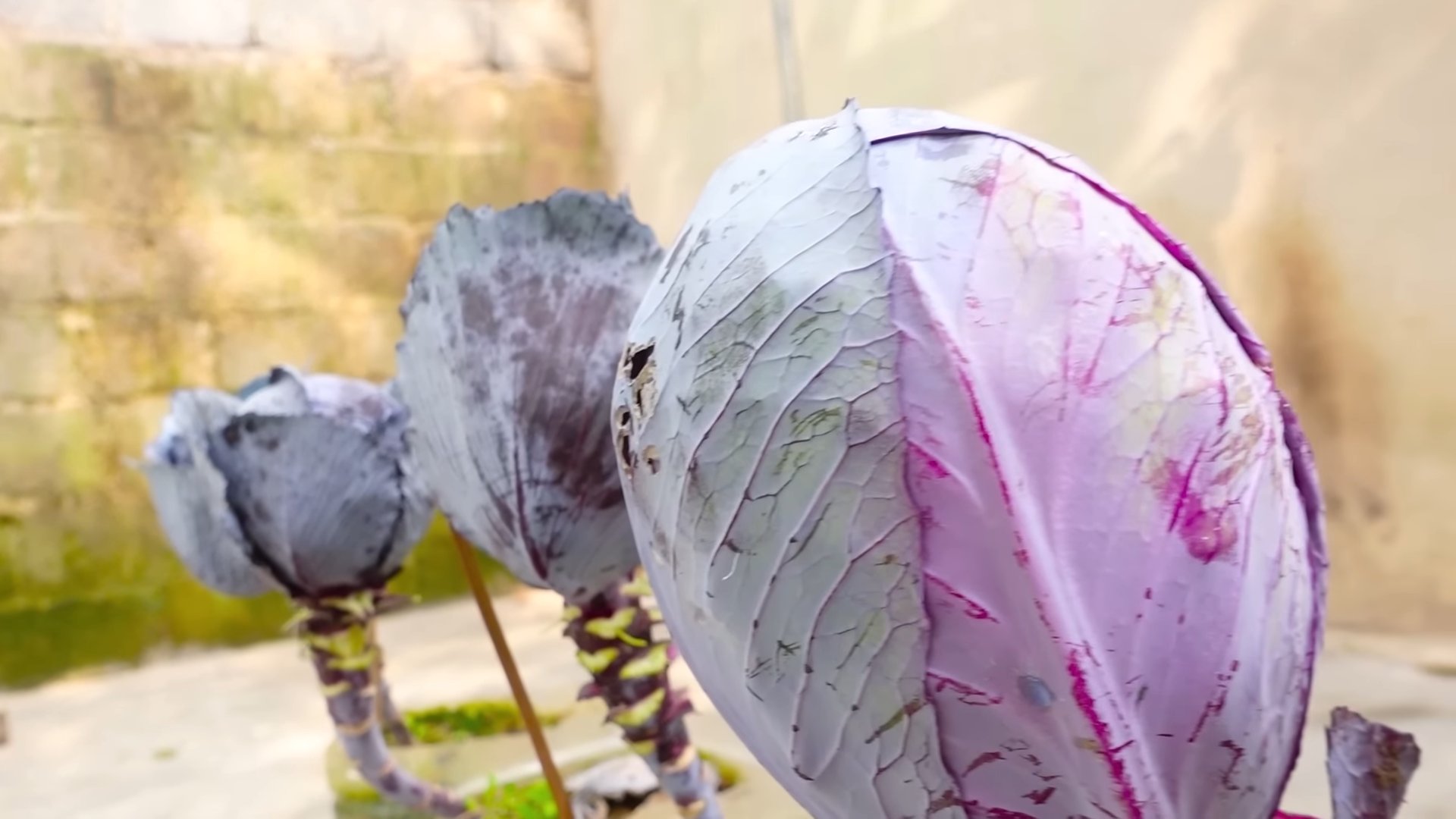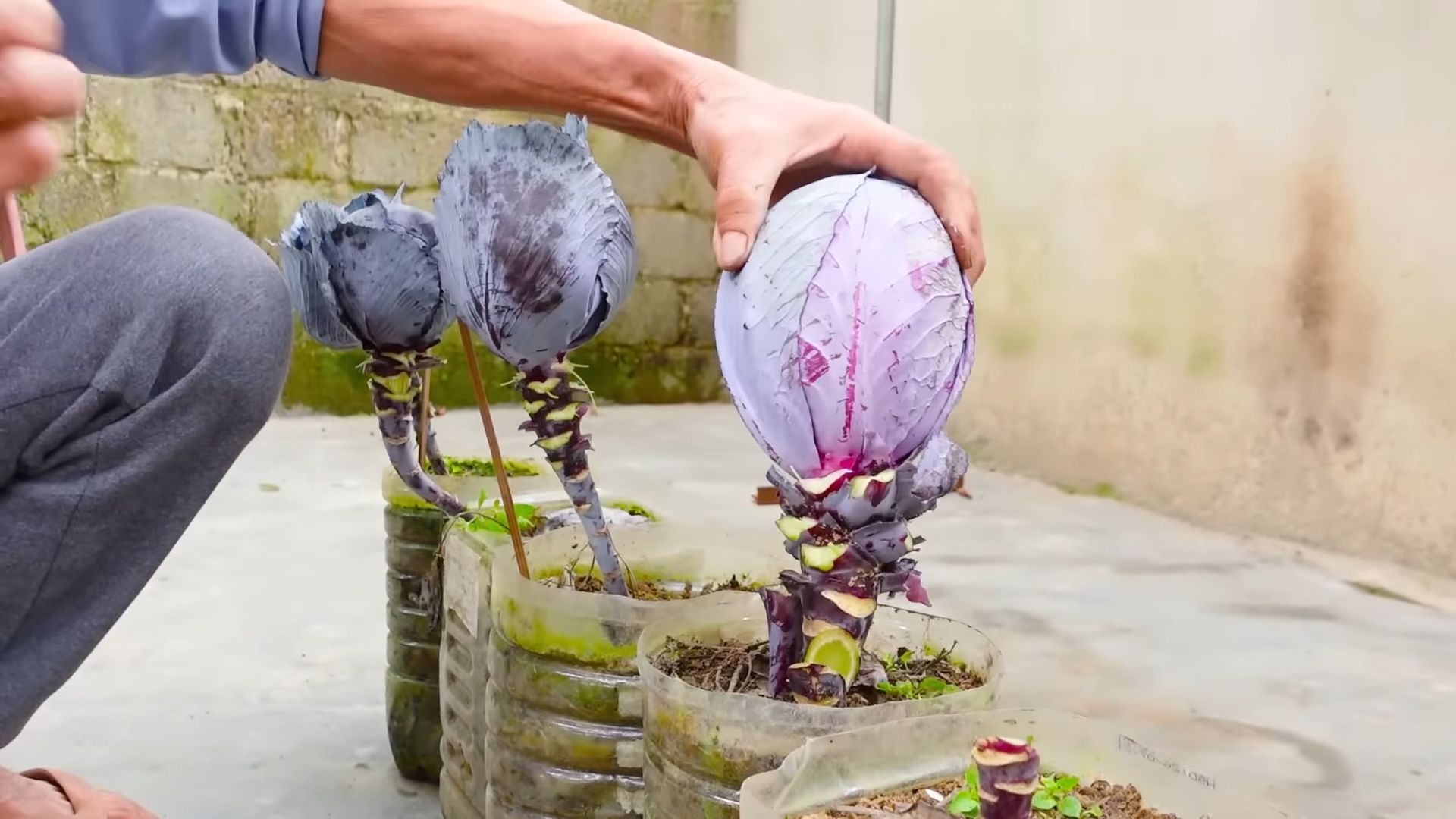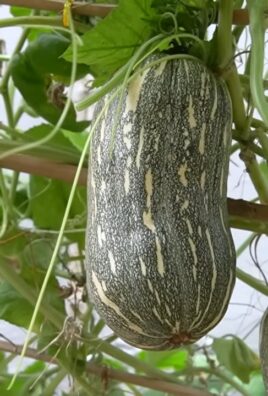Grow Purple Cabbage at Home and unlock a world of vibrant color and delicious flavor right in your backyard! Have you ever dreamed of harvesting your own gorgeous, jewel-toned vegetables? Well, dream no more! This DIY guide will walk you through the surprisingly simple steps to cultivating your very own purple cabbage, even if you’re a complete beginner.
Cabbage, in general, has a rich history, dating back thousands of years. From ancient Rome, where it was prized for its medicinal properties, to its prominent place in European cuisine, cabbage has nourished civilizations. But purple cabbage? It’s not just nutritious; it’s a showstopper! Its striking color, thanks to anthocyanins (powerful antioxidants!), adds a touch of elegance to any dish.
Why should you bother to grow purple cabbage at home? Because store-bought cabbage simply can’t compare to the freshness and satisfaction of harvesting your own. Plus, you’ll know exactly what went into growing it – no harmful pesticides or mystery ingredients! Imagine the vibrant slaws, colorful salads, and stunning stir-fries you can create with your homegrown purple cabbage. This DIY project is not only rewarding but also a fantastic way to connect with nature, save money, and impress your friends and family with your gardening prowess. Let’s get started!

Growing Gorgeous Purple Cabbage at Home: A DIY Guide
Hey there, fellow gardening enthusiasts! I’m so excited to share my experience with growing vibrant purple cabbage right in my own backyard. It’s easier than you might think, and the payoff – a beautiful, nutritious, and delicious vegetable – is totally worth it. This guide will walk you through every step, from seed to harvest, so you can enjoy your own homegrown purple cabbage.
Choosing Your Purple Cabbage Variety
Before we dive into the nitty-gritty, let’s talk about variety. Just like with other vegetables, there are different types of purple cabbage, each with its own characteristics. Here are a few popular options:
* ‘Red Acre’: This is a classic, reliable variety that produces medium-sized, round heads with a deep purple color. It’s known for its good storage capabilities.
* ‘Ruby Ball’: If you’re looking for a smaller, more compact cabbage, ‘Ruby Ball’ is a great choice. It matures quickly and has a beautiful, vibrant red-purple hue.
* ‘Red Express’: As the name suggests, this variety is known for its early maturity. It produces smaller heads and is perfect for those who want a quick harvest.
* ‘Primero’: This is a hybrid variety that offers excellent disease resistance and produces uniform, round heads.
I personally love ‘Red Acre’ because of its size and storage potential, but feel free to experiment and find the variety that best suits your needs and preferences.
Getting Started: Planting Your Purple Cabbage
Okay, let’s get our hands dirty! You can start purple cabbage from seed indoors or directly sow them in your garden, depending on your climate and the length of your growing season. I prefer starting indoors to get a head start.
Starting Seeds Indoors (Recommended)
This method gives you more control over the early stages of growth and protects your seedlings from harsh weather.
1. Gather Your Supplies: You’ll need seed starting trays or small pots, seed starting mix (a light, well-draining soil), purple cabbage seeds, a spray bottle, and a grow light (optional, but highly recommended).
2. Sow the Seeds: Fill your seed starting trays or pots with the seed starting mix. Moisten the soil gently with the spray bottle. Sow 2-3 seeds per cell or pot, about ¼ inch deep.
3. Provide Light and Warmth: Place the trays or pots in a warm location (around 70-75°F or 21-24°C). If you’re using a grow light, position it a few inches above the soil surface. If not, place the trays near a sunny window.
4. Keep the Soil Moist: Water the seedlings regularly, keeping the soil consistently moist but not waterlogged. Use a spray bottle to avoid disturbing the delicate seedlings.
5. Thin the Seedlings: Once the seedlings have developed their first true leaves (the second set of leaves), thin them to one seedling per cell or pot. Choose the strongest, healthiest-looking seedling and gently snip off the others at the soil line.
6. Harden Off the Seedlings: About a week before you plan to transplant the seedlings outdoors, you’ll need to “harden them off.” This process gradually acclimates them to outdoor conditions. Start by placing the seedlings outdoors in a sheltered location for a few hours each day, gradually increasing the amount of time they spend outside.
Direct Sowing (If Your Climate Allows)
If you live in a region with a long growing season and mild temperatures, you can directly sow purple cabbage seeds in your garden.
1. Prepare the Soil: Choose a sunny location with well-drained soil. Amend the soil with compost or other organic matter to improve its fertility and drainage.
2. Sow the Seeds: Sow the seeds about ½ inch deep and 1-2 inches apart in rows.
3. Water Regularly: Keep the soil consistently moist until the seedlings emerge.
4. Thin the Seedlings: Once the seedlings are a few inches tall, thin them to about 18-24 inches apart.
Transplanting Your Purple Cabbage Seedlings
Whether you started your seeds indoors or purchased seedlings from a nursery, transplanting them into your garden is a crucial step.
1. Choose the Right Time: Transplant your seedlings outdoors after the last frost. Purple cabbage can tolerate light frost, but it’s best to wait until the weather has warmed up a bit.
2. Prepare the Planting Site: Choose a sunny location with well-drained soil. Amend the soil with compost or other organic matter to improve its fertility and drainage. Cabbage prefers a soil pH between 6.0 and 7.5.
3. Dig the Holes: Dig holes that are slightly larger than the root balls of your seedlings. Space the holes 18-24 inches apart.
4. Transplant the Seedlings: Gently remove the seedlings from their containers and loosen the root balls slightly. Place each seedling in a hole and backfill with soil, gently firming the soil around the base of the plant.
5. Water Thoroughly: Water the seedlings thoroughly after transplanting.
6. Mulch: Apply a layer of mulch around the plants to help retain moisture, suppress weeds, and regulate soil temperature. I like to use straw or shredded leaves.
Caring for Your Purple Cabbage Plants
Now that your purple cabbage plants are in the ground, it’s time to provide them with the care they need to thrive.
* Watering: Purple cabbage needs consistent moisture, especially during hot, dry weather. Water deeply and regularly, aiming to keep the soil consistently moist but not waterlogged.
* Fertilizing: Feed your purple cabbage plants with a balanced fertilizer every few weeks. You can use a liquid fertilizer or a granular fertilizer. Follow the instructions on the fertilizer package. I like to use a fertilizer that is high in nitrogen, as this promotes leafy growth.
* Weeding: Keep the area around your purple cabbage plants free of weeds. Weeds compete with the cabbage for water and nutrients.
* Pest Control: Purple cabbage can be susceptible to pests such as cabbage worms, aphids, and flea beetles. Inspect your plants regularly for signs of pests and take action if necessary. You can use organic pest control methods such as insecticidal soap or neem oil. I’ve found that covering my plants with row covers can also be very effective in preventing pest infestations.
* Disease Prevention: Purple cabbage can also be susceptible to diseases such as black rot and clubroot. To prevent these diseases, choose disease-resistant varieties, practice crop rotation, and avoid overwatering.
Harvesting Your Purple Cabbage
The moment you’ve been waiting for! Harvesting your own homegrown purple cabbage is incredibly satisfying.
1. Check for Maturity: Purple cabbage is typically ready to harvest when the heads are firm and dense. The size of the head will vary depending on the variety, but generally, you can expect heads to be 6-8 inches in diameter.
2. Harvesting: Use a sharp knife to cut the cabbage head from the stem. Leave a few outer leaves on the stem to protect the remaining plant.
3. Storage: Purple cabbage can be stored in the refrigerator for several weeks. Wrap the cabbage head in plastic wrap or place it in a plastic bag to prevent it from drying out.
Troubleshooting Common Problems
Even with the best care, you might encounter some challenges along the way. Here are a few common problems and how to address them:
* Cabbage Worms: These green caterpillars can quickly devour your cabbage leaves. Handpick them off the plants or use Bacillus thuringiensis (Bt), a natural insecticide.
* Aphids: These tiny insects suck the sap from plants, causing them to weaken. Spray them off with a strong stream of water or use insecticidal soap.
* Flea Beetles: These small, jumping beetles can create tiny holes in the leaves. Cover your plants with row covers or use diatomaceous earth.
* Heads Splitting: This can happen if the cabbage receives too much water after a dry spell. Ensure consistent watering and harvest the cabbage as soon as it’s mature.
* Lack of Head Formation: This can be caused by insufficient sunlight, poor soil, or lack of nutrients. Ensure your plants are getting at least 6 hours of sunlight per day, amend the soil with compost, and fertilize regularly.
Enjoying Your Homegrown Purple Cabbage
Now that you’ve harvested your beautiful purple cabbage, it’s time to enjoy the fruits (or vegetables!) of your labor. Purple cabbage is incredibly versatile and can be used in a variety of dishes. Here are a few ideas:
* Salads: Shredded purple cabbage adds a vibrant color and crunchy texture to salads.
* Slaws: Purple cabbage is a key ingredient in many slaws.
* Stir-fries: Add chopped purple cabbage to stir-fries for a healthy

Conclusion
So, there you have it! Growing your own vibrant, delicious purple cabbage at home is not only achievable, but also incredibly rewarding. Forget those lackluster, often overpriced heads at the grocery store. With a little patience and these simple steps, you can cultivate a garden bursting with beautiful, nutrient-rich purple cabbage, ready to be transformed into stunning salads, slaws, and so much more.
This DIY trick isn’t just about saving money; it’s about connecting with your food, understanding its journey from seed to table, and enjoying the unparalleled freshness that only homegrown produce can offer. Imagine the satisfaction of serving a dish featuring purple cabbage you nurtured yourself – the vibrant color, the crisp texture, and the subtly sweet flavor will be unlike anything you’ve tasted before.
But the benefits don’t stop there. Growing your own purple cabbage allows you to control the entire process, ensuring that your vegetables are free from harmful pesticides and chemicals. You can choose organic seeds and fertilizers, creating a truly healthy and sustainable food source for yourself and your family.
Don’t be afraid to experiment! Try different varieties of purple cabbage to discover your favorite flavor profile. Some varieties are sweeter, while others have a more peppery bite. You can also adjust the growing conditions to influence the color intensity – cooler temperatures tend to produce deeper, more vibrant purple hues. Consider companion planting with herbs like rosemary or thyme to deter pests and enhance the flavor of your cabbage.
And if you’re feeling adventurous, why not try pickling your homegrown purple cabbage? The vibrant color and tangy flavor make it a stunning addition to any charcuterie board or sandwich. Or, ferment it into sauerkraut for a probiotic-rich superfood. The possibilities are endless!
We wholeheartedly encourage you to give this DIY trick a try. It’s a fantastic way to get your hands dirty, learn about gardening, and enjoy the fruits (or rather, vegetables) of your labor. Whether you have a sprawling backyard garden or a small balcony container, there’s a way to grow purple cabbage at home.
Once you’ve harvested your first head of homegrown purple cabbage, we’d love to hear about your experience! Share your photos, tips, and recipes in the comments below. Let’s create a community of home gardeners who are passionate about growing their own food and enjoying the many benefits of fresh, homegrown produce. Your insights could inspire others to embark on their own purple cabbage growing journey. So, grab your seeds, get your hands dirty, and get ready to enjoy the delicious rewards of growing your own purple cabbage!
Frequently Asked Questions (FAQ)
What is the best time of year to plant purple cabbage?
The ideal time to plant purple cabbage depends on your climate. In general, purple cabbage thrives in cooler temperatures. For spring harvests, start seeds indoors 6-8 weeks before the last expected frost. Transplant seedlings outdoors 2-3 weeks before the last frost. For fall harvests, sow seeds directly into the garden in mid-summer, about 6-8 weeks before the first expected frost. In warmer climates, you can grow purple cabbage throughout the winter.
How much sunlight does purple cabbage need?
Purple cabbage requires at least 6 hours of direct sunlight per day to thrive. Choose a sunny location in your garden or on your balcony. If you’re growing cabbage indoors, use grow lights to supplement natural sunlight. Insufficient sunlight can result in leggy plants and smaller heads.
What kind of soil is best for growing purple cabbage?
Purple cabbage prefers well-drained, fertile soil with a pH between 6.0 and 7.0. Amend your soil with compost or other organic matter to improve drainage and fertility. A slightly acidic soil is ideal. You can test your soil pH using a soil testing kit available at most garden centers.
How often should I water purple cabbage?
Purple cabbage needs consistent moisture to thrive. Water deeply and regularly, especially during dry periods. Aim to keep the soil consistently moist but not waterlogged. Mulching around the plants can help retain moisture and suppress weeds. Check the soil moisture regularly by sticking your finger about an inch into the soil. If it feels dry, it’s time to water.
What are some common pests and diseases that affect purple cabbage?
Common pests that affect purple cabbage include cabbage worms, aphids, and flea beetles. Diseases include clubroot, black rot, and downy mildew. To prevent pests and diseases, practice crop rotation, keep your garden clean, and use organic pest control methods such as insecticidal soap or neem oil. Covering your plants with row covers can also help protect them from pests.
How long does it take for purple cabbage to mature?
Purple cabbage typically takes 70-90 days to mature from seed. The exact time will depend on the variety and growing conditions. You can harvest your cabbage when the head is firm and the desired size.
How do I know when my purple cabbage is ready to harvest?
The best way to determine if your purple cabbage is ready to harvest is to gently squeeze the head. If it feels firm and solid, it’s likely ready. The size of the head will also depend on the variety, so check the seed packet for specific information.
Can I grow purple cabbage in containers?
Yes, you can grow purple cabbage in containers. Choose a large container that is at least 12 inches in diameter and 12 inches deep. Use a well-draining potting mix and provide adequate sunlight and water. Container-grown cabbage may require more frequent watering and fertilization than cabbage grown in the ground.
How do I store purple cabbage after harvesting?
Store harvested purple cabbage in the refrigerator. Wrap the head in plastic wrap or place it in a plastic bag to prevent it from drying out. Purple cabbage can last for several weeks in the refrigerator.
What are some ways to use purple cabbage in cooking?
Purple cabbage is a versatile vegetable that can be used in a variety of dishes. It can be eaten raw in salads and slaws, or cooked in stir-fries, soups, and stews. It can also be pickled or fermented. The vibrant color of purple cabbage makes it a beautiful addition to any meal.
Why is my purple cabbage not as purple as I expected?
The intensity of the purple color in cabbage can be affected by several factors, including soil pH and temperature. More acidic soils tend to produce more vibrant purple hues. Cooler temperatures also promote deeper coloration. If your cabbage isn’t as purple as you’d like, try adjusting the soil pH or growing it in a cooler location.
Can I save seeds from my purple cabbage?
Saving seeds from purple cabbage is possible, but it requires allowing the plant to overwinter and produce flowers in its second year. This is a more advanced gardening technique and may not be feasible in all climates. If you’re interested in saving seeds, research the specific requirements for your region.




Leave a Comment